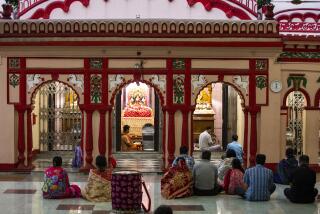3 Slain as 5,000 Protest in Bangladesh
- Share via
DHAKA, Bangladesh — Riot police shot and killed three people Tuesday as about 5,000 demonstrators tried to force the resignation of President Hussain Mohammed Ershad.
About 6,000 policemen used shotguns and tear gas against rock-throwing demonstrators taking part in a day of protest billed as the “Siege of Dhaka.” There was no serious disruption of government activity.
By nightfall, government officials were claiming victory over the united opposition, including the powerful Bangladesh National Party, the Awami League and the fundamentalist Muslim Jamat Islami.
“The myth that the opposition could bring down the government very easily has been exploded,” the minister of home affairs, Dr. Mohammed Abdul Matin, said in a public statement. “We were supposed to resign; we didn’t. They were supposed to force us to resign; they didn’t.”
The turnout of demonstrators was relatively small in light of conditions in Bangladesh, where more than 100 million impoverished people live in an area about half the size of Italy. However, opposition leaders insisted that they had made their point.
“We were 100% successful,” Khaleda Zia, leader of the National Party, told reporters. “Ershad has to resign. It is only a matter of time.”
Zia and Hassina Wajed, head of the Awami League, called for a nationwide strike today to press their campaign against Ershad.
Some opposition people complained that harsh steps taken by the government in advance of Tuesday’s demonstration, including the arrest of about 1,400 political activists and the two-day suspension of bus, rail and boat service into the city, impaired their ability to get their followers to the scene.
Military-Style Operation
“Ershad looks upon the people as his enemy,” said Kemal Hussain of the Awami League. “So, he denied the capital to the enemy. He thought he was directing a military operation.”
Ershad, a former army general, took power in 1982 in a coup d’etat . In the last two years, he has attempted to carry out a number of democratic reforms, among them the removal of martial law.
Home Minister Matin, a surgeon turned public official, said all three of Tuesday’s deaths occurred in a clash between demonstrators and policemen in the Motijheel district near the government office complex.
He said 15 policemen were injured in the fighting, which included several bomb explosions, and that 236 demonstrators were arrested.
Most government workers turned up for work despite the protest.
At the main branch of the government-run Sonali Bank, all the desks and teller windows were occupied, but only a few customers were on hand. Many government workers, threatened with losing their jobs if they failed to appear for work, had spent the night at their offices.
“More than 94% attended their jobs,” Matin said. “All industries . . . were running at full speed.”
However, nearly all private shops and businesses were closed. Several fires were set. A U.S. Information Agency office and a Pan American World Airways ticket office were slightly damaged.
By the end of the day, the demonstrators had been largely dispersed. A Western diplomat who followed the day’s events remarked: “They were not exactly a failure for the opposition, but they fell far short of what they had hoped. They were not the kind of thing that leads to a change in government.”
Matin, who has emerged as an articulate spokesman for the Ershad government, said: “They had an ambitious program to bring 5 million demonstrators to Dhaka. They had 5,000. The so-called siege degenerated into acts of anarchy, vandalism, arson and attempts to create civil disorder.”
More to Read
Sign up for Essential California
The most important California stories and recommendations in your inbox every morning.
You may occasionally receive promotional content from the Los Angeles Times.













